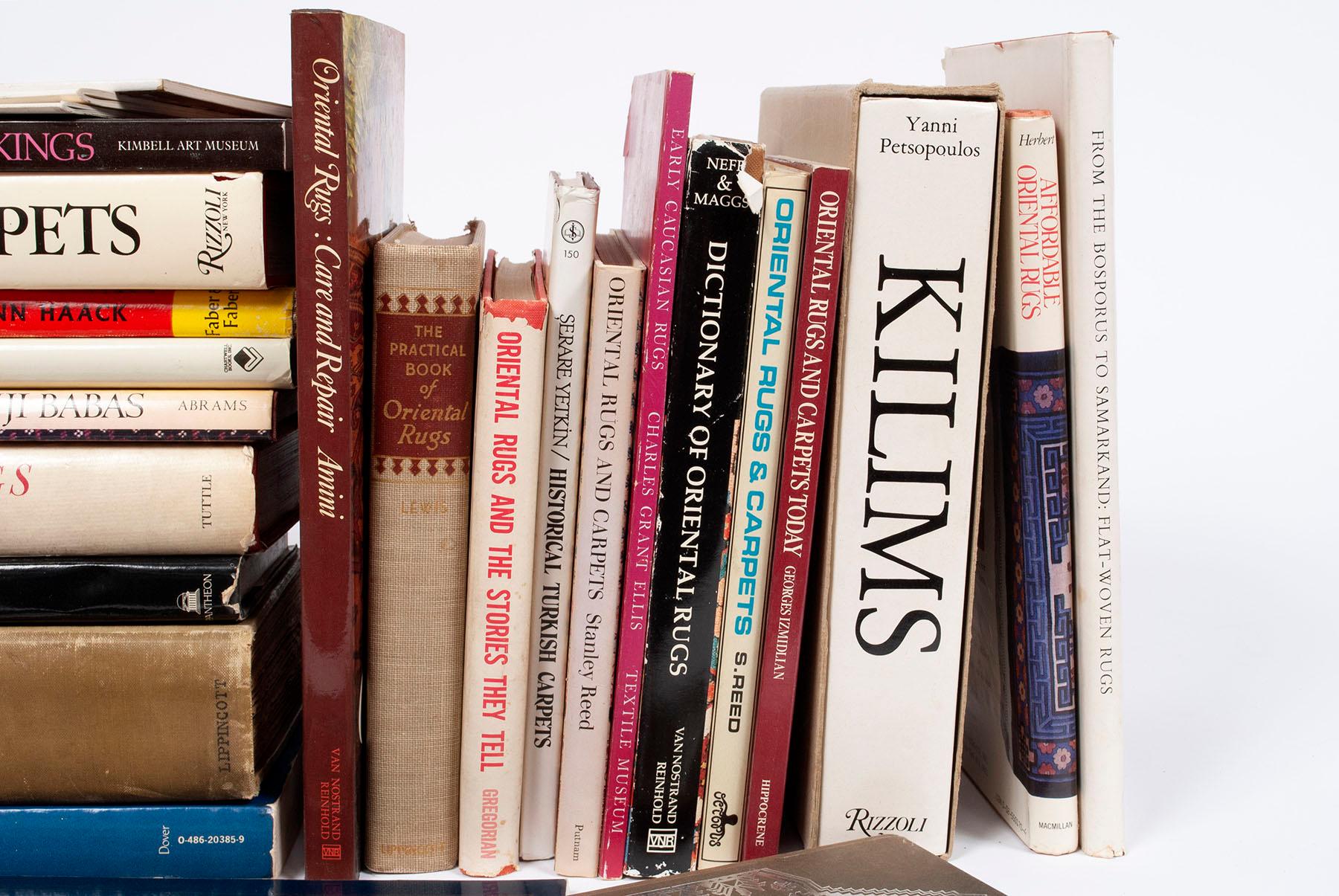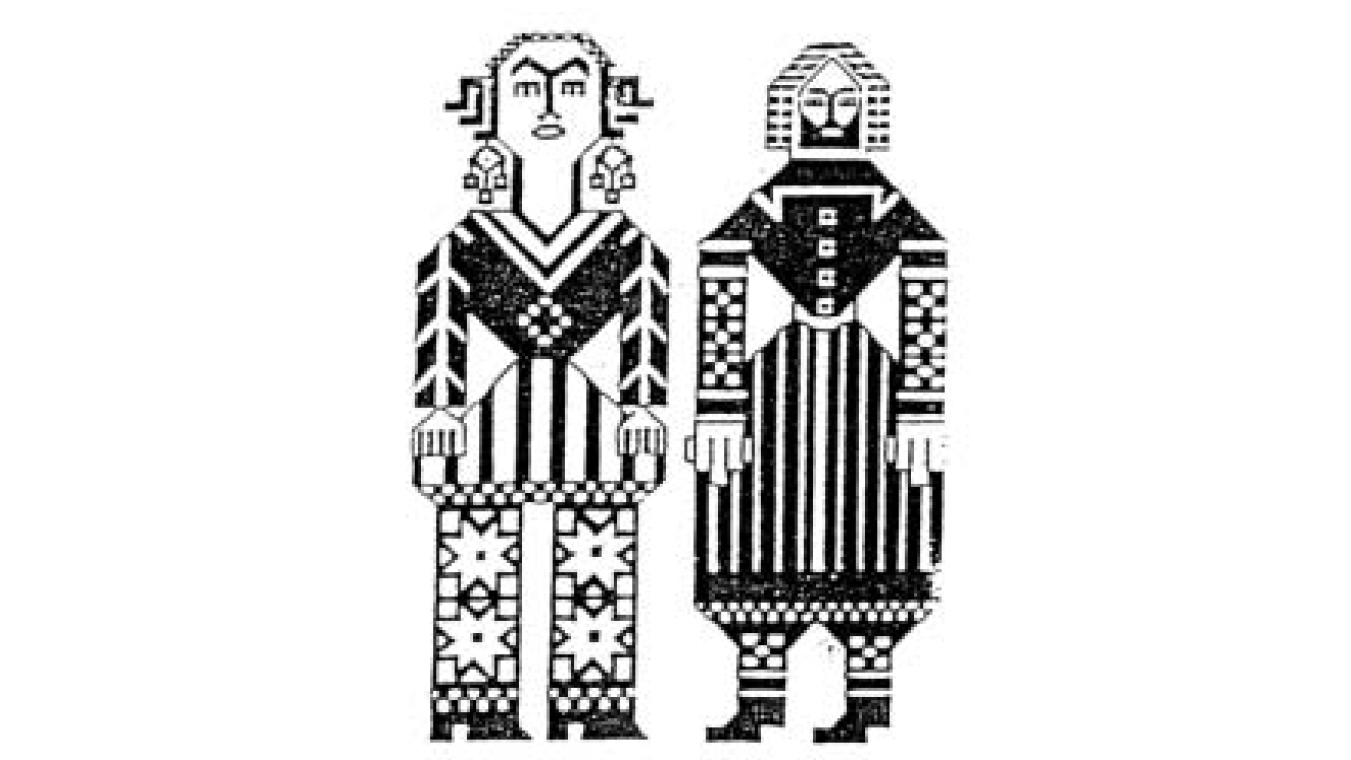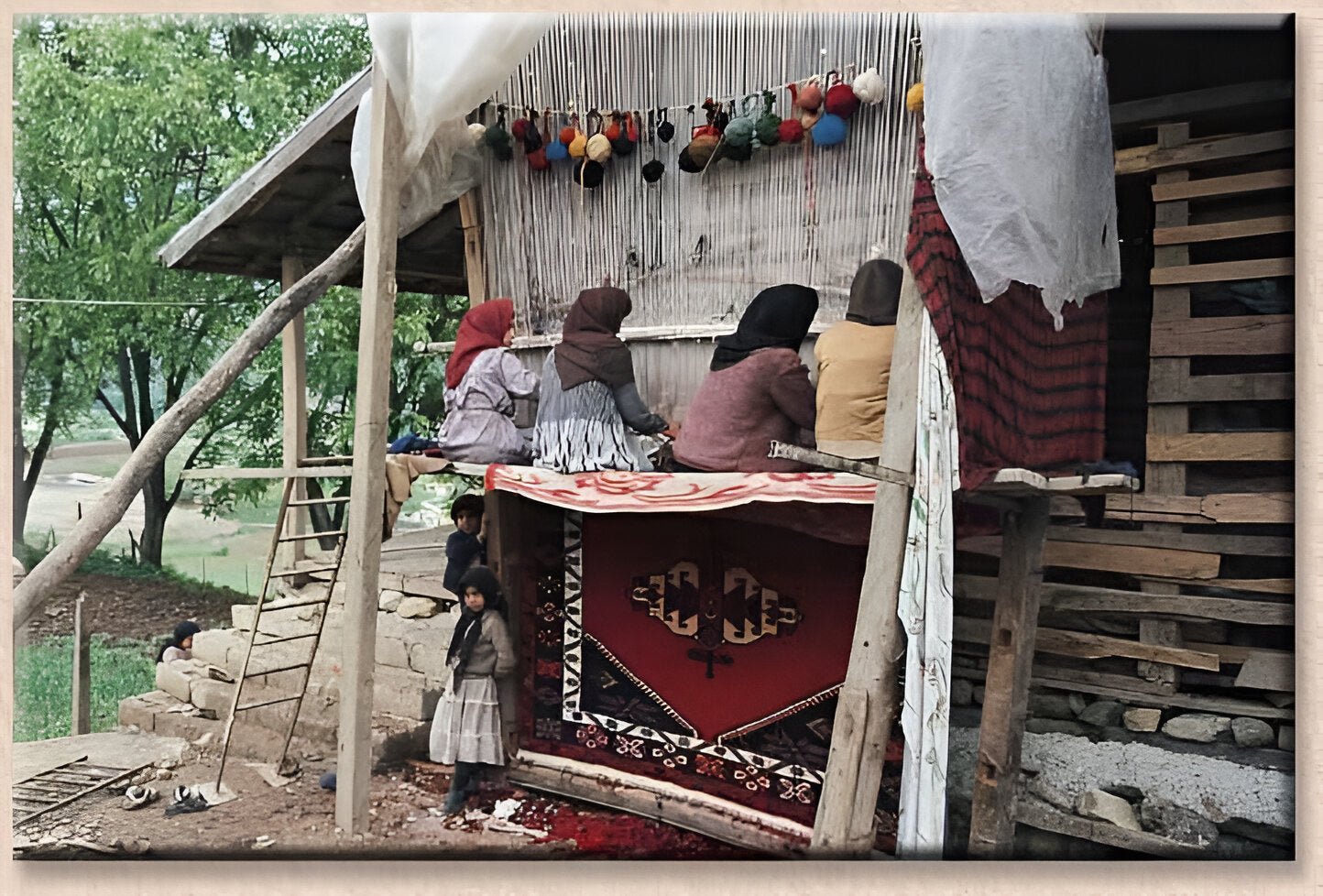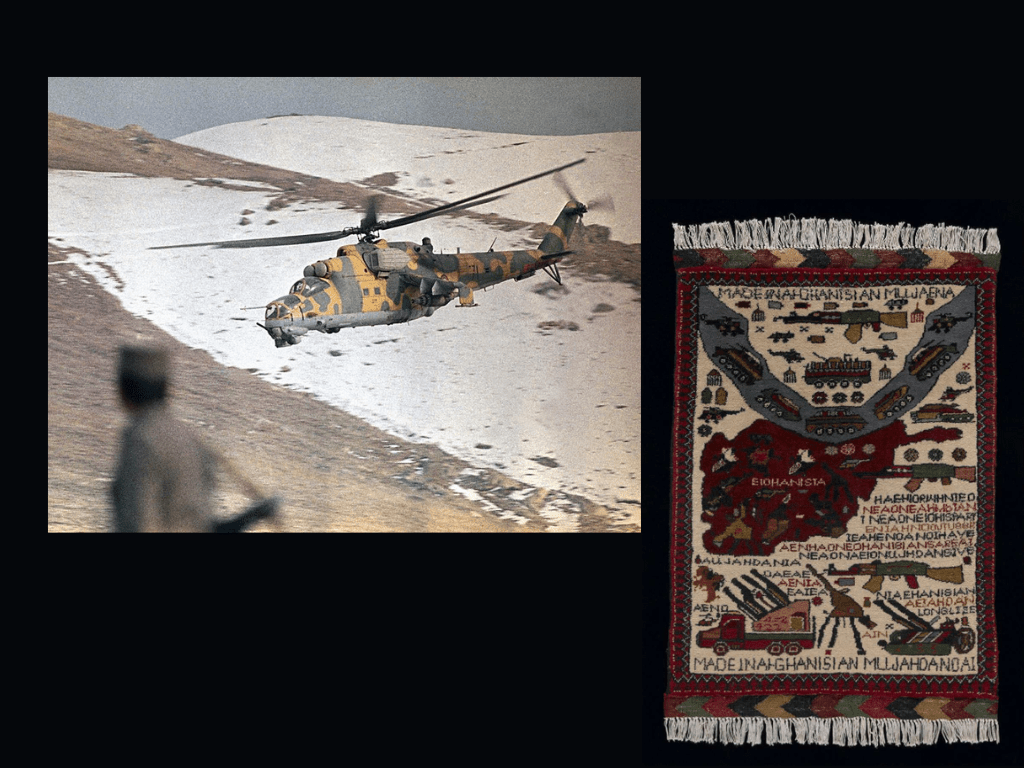Afghan war rugs offer a striking lens into how prolonged conflict reshapes artistic traditions. For over four decades Afghanistan has faced relentless turmoil, from the Soviet invasion in 1979 to civil strife and the rise of the Taliban.
Throughout these trials, war-themed rugs have persisted as a unique form of expression, intertwining historic weaving practices with vivid depictions of warfare and resilience.

Afghan war rug from the Soviet-Afghan War era. Traditional borders and tassels frame images of blockhouses, tanks, and helicopters symbolizing the Soviet invasion. The British Museum.
What Are War Rugs?
Wartime-influenced weavings have appeared in various regions (Chile, Peru, Vietnam, Thailand, Palestine, Egypt), but Afghanistan’s long, widespread conflict and the large output of war rugs over decades set them apart.
The term “war rugs” generally refers to carpets woven since the early 1980s when Afghanistan’s wars intensified. These rugs incorporate themes of personal experience, shock, and cultural upheaval, becoming both a means of coping and a political statement.
Art historian Nigel Lendon of Australian National University describes Afghan war rugs as “the highest tradition of war art in the twentieth century,” noting that their impact is broader than many other artistic responses to conflict.
The weavings became an accessible canvas for ordinary people (often women weavers) to document the violence around them when other forms of expression were limited.
Carpet weaving is a cherished art in Afghanistan. After years of invasion, internal strife, and oppressive regimes, weavers began adding new imagery—tanks, helicopters, rifles, maps, even portraits of leaders—into traditional patterns as a chronicle of national crises.
Early pieces subtly blended war motifs with age-old floral or geometric designs; later rugs made bolder statements with obvious references to weaponry and events. Over time, three overlapping “generations” of war rugs emerged, each reflecting the era of conflict in which it was woven.

Soviet soldiers directing tank traffic near Kabul in 1980. Scenes like this formed the real-life backdrop for motifs seen in many first-generation Afghan war rugs (AP Photo)
First Generation: The Soviet-Afghan War (1979–1989)
Emergence and Characteristics: The first war rugs appeared in direct response to the Soviet invasion. Many early examples were woven by Baluchi weavers in northwest Afghanistan (Herat region) in the 1980s.
These retained traditional Baluch or Turkmen patterns—such as octagonal gulls or floral motifs—but discreetly incorporated military elements. Weapons and aircraft might be hidden among flowers, or arranged in symmetric patterns so as not to overwhelm the classic design.
The aggressive imagery was subtle at first: brokers initially refused overt war designs, fearing buyers would be put off. Some rugs from this period even included inscriptions that resembled Cyrillic letters, hinting at Soviet influence or intended Russian buyers.
Many first-generation rugs remained balanced and symmetric despite the new motifs. For example, an “armored vehicles and cityscape” design showed tanks or helicopters placed in orderly rows around a traditional central medallion, or a “Kalashnikov border” pattern might hide rifles in the vine scrolls.
These subtle inclusions allowed the rugs to serve as quiet acts of resistance and documentation, without abandoning the familiar aesthetic.
Influence and Production: As fighting intensified, many Afghan families fled to refugee camps in Pakistan. Camps like Faisal (in the North-West Frontier Province) became hubs of war rug production outside Afghanistan.
In Peshawar—a major center for Afghan rug traders—small workshops sprang up where patterns were adapted for international consumers.
By the mid-1980s, European and American visitors and soldiers began seeking these unusual “war souvenirs.”
Commercial demand started shaping the imagery: weavers noticed foreigners were intrigued by depictions of tanks and guns.
Sayed Ahmad Gailani, a mujahideen leader, observed this transformation, saying: “Until ten years ago, people wove rugs with deer and camels, but now only tanks, military planes, and bombers are seen” (Bonyhady et al., 2003).
In other words, market interest encouraged bolder war themes.
Some key design groups from this first generation include:
- Traditional Motifs with Hidden Weapons: Rugs that at a glance look traditional, but upon closer inspection have tanks, grenades, or soldiers woven subtly among the usual patterns of flowers, camels, or tribal emblems.
- Cityscapes with Military Equipment: Designs featuring stylized maps or city layouts encircled by helicopters, fighter jets, and columns of tanks. Often these depicted scenes of Soviet occupation, like convoys moving through Afghan valleys.
- The Kalashnikov as Central Motif: Some rugs gave the AK-47 rifle a place of prominence (as it symbolized the Mujahideen resistance). These might show repeated rows of rifles or a large AK-47 flanked by tribal patterns, merging modern weaponry with traditional design.
- Heavy Soviet Hardware in Repetition: Motifs of tanks, armored personnel carriers, and combat helicopters arranged in neat grids or borders, reflecting the overwhelming presence of Soviet military machinery.
Tip: By the late 1980s, war rug production had become quite commercialized. Foreign aid workers, journalists, and soldiers were buying these rugs, and weavers started creating patterns specifically for sale. This sometimes meant accuracy took a backseat to aesthetic appeal—tanks might be bright blue or rifles oddly shaped, since weavers drew from imagination or secondhand descriptions.
One striking example from this era shows Afghan fighters and Russian soldiers in combat, woven in a style reminiscent of Persian paintings. In that 1980s war rug, the Afghan fighters are depicted heroically while the Russian soldiers have been given horned, demon-like features (drawing on the imagery of evil figures in literature).
Even in war rugs, weavers found ways to incorporate cultural storytelling: portraying invaders as monsters recalls epic tales from the Shahnameh (the Persian Book of Kings) where heroes slay demons.

A wartime rug from the 1980s showing Afghan vs. Russian soldiers. Note the horned “div” (demon) figure used to represent a Russian, inspired by traditional epics. Tanks, camels, and Farsi inscriptions also appear. (The British Museum)
Second Generation: Civil War and Taliban Era (1989–2001)
Shifts After the Soviets Left: When Soviet forces withdrew in 1989, Afghanistan spiraled into internecine fighting among warlords, then into the harsh rule of the Taliban.
War rugs during this period were woven both in refugee communities across the border and in Afghanistan’s embattled regions.
The themes evolved and, in some cases, the craftsmanship changed as well. Notably, men began to join women in weaving during this time (a departure from the earlier norm), especially in refugee workshops.
Many weavers continued war rug motifs as a form of income, but global interest had waned after the Soviets’ exit, resulting in rugs catering to a smaller market of collectors and NGOs.
English inscriptions, sometimes misspelled, started appearing more frequently on these rugs in the 1990s. Words like “Hand Bom” (for “Hand Bomb”), “Rooket” (“Rocket”), or labels like “Made in Afghanistan” found their way into the designs. This use of English (and sometimes dates or slogans) was a clear nod to Western audiences.
The artistry also became more free-form; the balanced symmetry of earlier pieces gave way to more chaotic, collage-like layouts, perhaps mirroring the country’s instability in the 1990s.
Weavers were experimenting: while some returned to purely traditional floral motifs to attract buyers no longer interested in war, others pushed political commentary through pictorial rugs.
Rugs of this second generation can be categorized into a few thematic groups:
-
Celebration of Soviet Defeat: These rugs explicitly commemorate the Mujahideen victory over the USSR. A common design shows Soviet tanks exiting Afghan territory, often with a map of Afghanistan and inscriptions announcing the “final defeat of Russian invaders.” Such rugs served as proud mementos of that victory, sometimes commissioned by or for Mujahideen commanders.
-
Portraits of Leaders and Heroes: Pictorial rugs emerged featuring figures like Ahmad Shah Massoud (the renowned resistance leader), or even earlier historical figures like King Amanullah Khan (who had fought the British and is revered for modernizing Afghanistan). Weavers wove detailed faces and clothing, showcasing these leaders almost like iconography. These portraits reflected local reverence and were popular in certain areas.
-
Political Satire – The Najibullah Rugs: Some bold weavers used rugs as a medium of political critique. Mohammad Najibullah, the Soviet-backed president left in Kabul, was a target of ridicule. In some rare rugs, Najibullah was depicted as a puppet or with exaggerated features controlled by outside forces. These caricature rugs were risky to create but demonstrate how rugs became akin to editorial cartoons in woven form.
-
Allegorical and Epic Designs: Influenced by literature and mythology, a subset of rugs wove contemporary events into allegorical scenes. For instance, a battle rug might subtly allude to a story from the Shahnameh or Quranic tale, drawing parallels between ancient battles of good vs. evil and the modern struggle. Alternatively, weavers would include symbols like the Simurgh (a mythical Persian bird) or verses of Persian poetry in the margins, offering commentary on current events through cultural metaphors.
During the 1990s, as Afghanistan faded from international headlines (until the very end of the decade), many weavers indeed shifted back to traditional designs to make a living.
Media coverage of the war rugs declined; the Soviet war was over and Western interest dipped. The United States and other powers had also largely disengaged from Afghanistan after 1989, meaning fewer foreign customers on the ground.
Thus, war rugs from roughly 1992 to 2000 became less common and often less elaborate, with exceptions mainly in areas where fighting continued or among those catering to niche collectors.
It wasn’t until the dramatic events of 2001 that war rugs roared back into global consciousness.

A war rug from the civil war era with a cream background and a green map of Afghanistan. It features Kalashnikov rifles, rocket launchers, anti-aircraft guns, and even poppy flowers. The mix of imagery hints at ongoing conflict and Afghanistan’s role in the opium trade. The British Museum.
Third Generation: Post-9/11 Global Attention (2001–2010s)
World Events Woven in Art: The September 11, 2001 attacks and the subsequent U.S.-led invasion of Afghanistan brought sudden worldwide attention back to the region. A new wave of “war rugs” emerged, this time depicting events far beyond Afghanistan’s borders.
Weavers began including the Twin Towers of the World Trade Center, scenes of airplanes crashing into skyscrapers, and even portraits of Osama bin Laden or George W. Bush in some instances. American flags appeared side by side with Afghan flags. Slogans praising foreign intervention or condemning terrorism were woven in English.
These pieces mirrored a new, globalized conflict that Afghanistan found itself in. The war rug had become a medium not just for Afghan experiences but for commenting on international events that now deeply affected Afghanistan’s future.
Commercialization and Quality Decline: The early 2000s saw foreign soldiers, journalists, aid workers, and contractors flooding Kabul and other cities. Many wanted a war rug as a souvenir of the “War on Terror.”
To meet this surge in demand, production ramped up quickly. Whereas earlier war rugs were often unique or made in small batches, now many designs were copied and woven en masse with only minor variations. This inevitably led to a drop in craftsmanship. Synthetic dyes and cheaper wool became more common to speed up production.
The weaving became less tight and detailed in many cases, and the artistic originality gave way to formulaic patterns (for example, countless rugs showing the Twin Towers with nearly identical layouts circulated in the mid-2000s).
Many of these rugs also adopted a tone and text aligning with Western narratives—phrases like “Afghanistan: War Against Terror 2001” or “We Welcome USA” appeared, which was a notable shift from the earlier war rugs that largely reflected Afghan perspectives.
It suggested that by this third phase, many war rugs were woven for the foreign audience explicitly, rather than as an organic Afghan folk art.
Common motifs in third-generation war rugs included:
-
Twin Towers and 9/11 Imagery: Perhaps the most iconic of this era, rugs showed the New York skyline with the Twin Towers struck by planes (often labeled “First Impact” and “Second Impact”), smoke billowing. Sometimes small falling figures were depicted, and at the bottom, an aircraft carrier launching jets might be included, representing the U.S. military response. It’s striking and somewhat jarring to see such scenes in a medium like carpet, but they capture the weavers’ absorbing of global news into their local art.
-
Flags, Doves, and Unity Symbols: Rugs portraying the Afghan flag and the American flag together became common, often joined by a white dove carrying an olive branch. These symbols suggested hope for peace and gratitude for liberation from the Taliban. Whether the sentiment was genuine or catering to buyers is hard to judge—likely a bit of both.
-
“War on Terror” Maps and Slogans: Some rugs wove maps of Afghanistan marked with key sites like Tora Bora (the mountain hideout bombarded in 2001) or Kandahar, along with tanks, drones, and labels like “Operation Enduring Freedom.” These served almost as storyboards of the new conflict. One could see labels for Al-Qaeda and Taliban positions, alongside dates or banners like “11 September 2001” or “Afghans Liberated from Terrorists,” reflecting the rhetoric of the time.
-
American Military Hardware: Just as Soviet tanks and AK-47s defined the first generation of war rugs, U.S. weaponry defined many third-gen pieces. Black Hawk helicopters, F-16 fighter jets, M16 rifles, even Predator spy drones and Humvee vehicles became familiar patterns. Often these were less artistically integrated and more plainly representational, giving the rugs a poster-like quality. Some even included portraits of American soldiers shaking hands with Afghan figures, symbolizing alliance.

A post-9/11 war rug depicting the Twin Towers during the attacks, flanked by American and Afghan flags and a peace dove above. English inscriptions narrate the event. This design, repeated many times in the early 2000s, catered to foreign buyers and memorialized a world-changing event. The British Museum.
The Cultural Impact of War Rugs
Across these three eras, Afghan war rugs have served as tangible records of the country’s continuous upheaval. They began as subtle acts of defiance and documentation by women who wove what they saw and felt during the Soviet occupation.
Over time, they evolved into commodities and political souvenirs, but even then they carried pieces of Afghanistan’s story into homes and museums worldwide.
Each “generation” of war rugs highlights shifts in Afghan society and external influence. The first generation’s pieces were deeply personal and local—fighting tanks with prayer and pattern within the confines of tradition. The second generation became more overt and sometimes propagandistic, reflecting power struggles and the search for new identity after foreign occupation. The third generation, influenced by globalization, showed how Afghan weavers could respond to events on the world stage, but also how market forces began to shape their art more than ever.
What started as intimate expressions of resistance turned into bolder political statements and eventually a mass-produced craft. Yet, war rugs remain more than mere curiosities or tourist trinkets; they are woven narratives of survival, identity, and adaptation. They chronicle how ordinary Afghans, especially craftswomen, perceived and processed war—from helicopters darkening their village skies in the 1980s, to the hope and uncertainty brought by foreign armies in the 2000s.
These rugs also challenge our conventional ideas of war art. As Nigel Lendon noted, the depictions in war rugs can be understood as a mirror of the West’s own representations of itself.
In other words, Afghan weavers often wove what they heard from Western media or propaganda (like the images of 9/11 and “war on terror” slogans which largely came from U.S. sources).
Thus, the rugs reflect not just Afghan realities but also Western narratives refracted through Afghan art. They have become conversation pieces that connect Kabul with New York, a village loom with the global war on terror.

Afghan War Rug (1980–1990) with a peach ground, multiple cobalt blue borders, and subtle war motifs, including four corner helicopters A small inscription in Farsi has been incorporated on one corner of the rug (possibly the weaver's signature). connected to war. The British Museum.
In summary: Afghan war rugs illuminate the resilience and creativity of a people under relentless strain. From Kalashnikov rifles hidden in floral borders to unmistakable images of the Twin Towers, the evolution of motifs tells a broader human story.
Studying these rugs gives us a deeper understanding of how conflict shapes art—and how art, in turn, preserves the memory of conflict for future generations.












Leave a comment